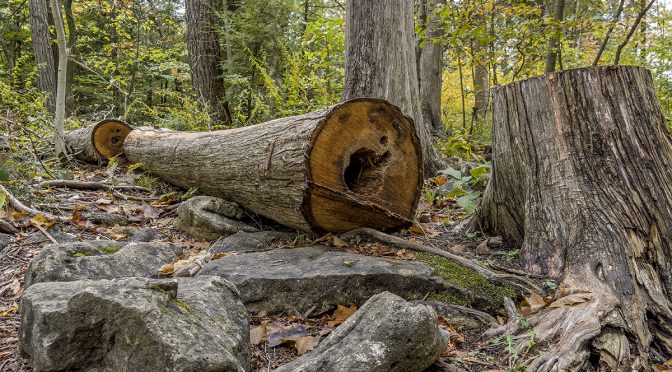This article shares a selection of landscape photographs and discusses factors that were considered when creating these Crawford Lake compositions.
NOTE: Click on images to enlarge.

A ‘rule-of-thirds’ composition with some emphasis on accentuating the contrast between the rail fence and sunlit grass. Foliage was included at the top of the photograph to help direct a viewer’s eye downward.

The bright red leaves caught my eye and I positioned them in centre frame to create some right to left eye flow. I brightened the yellow hue in post to give the foreground details a bit more pop.

Another composition that follows ‘rule of thirds’ element positioning. My eye was attracted to the triangular shape created by the red leaves entering from the right hand side.

In this composition the top of the fence railing was used as a strong leading line. It also serves as a corner exit.

I positioned the subject leaf on one side to create some eye flow. Notice the small, out-of-focus yellow highlight on the left hand side and the yellow shape just above the subject. These colour highlights help to frame the featured leaf and create some colour balance.
The three yellow elements help encourage a viewer’s eye to exit at the top right corner of the composition. Creating a triangular shape of colour highlights can often help create balance in a composition.
I darkened the shadows and added black in post to create more contrast in the composition.

The green bush in the lower right acts as a corner anchor. It helps create a feeling of intimacy and accentuates the leading line created by the pathway. Notice how the five large trees on the right hand side have equal spacing between them and create a repeating pattern.

The tree trunk on the right hand side was purposely cropped off to create a subject bleed. This composition technique helps to direct a viewer’s eye to the left and centre of the photograph.

In situations where a photographer wants to use large tree to help create a feeling of depth, it can be helpful to allow a viewer’s eye to flow past it on both sides. You’ll notice how the large tree on the left hand side was positioned using equidistant composition to create balance.

Creating compositions along trails and footpaths can often necessitate a photographer finding a precise physical position for themselves and their camera. You’ll notice four tree trunks on the left hand side of the composition that form a strong vertical repeating pattern. The visual space between each of these four trees was as equal as I could make them. This helps to accentuate the repeating pattern.

The photograph above is one that relies on the geometric alignment of various elements in the composition.
Starting in the left hand bottom corner, the rocks and base of the tree stump lead the viewer’s eye from left to right. The vertical grain of the stump pulls a viewer’s eye upward until it reaches the point where the stump was cut with a chain saw. The slight downward angle of this cut is aligned with the fallen log in centre frame. Eye flow is then directed to the circular shape of the cut end of a log positioned in centre frame.
To create this image I held my E-M1X low to the ground and used the articulated screen to compose the photograph. If you check the EXIF data you’ll see that I used the telephoto end of the M.Zuiko PRO 7-14 mm f/2.8 as this helps compress the various elements in the composition, while still allowing me to get in tight to the subject matter in the foreground.

To create more depth-of-field in a composition using the widest focal length possible is often preferred as you can see in the photograph above. Getting in very tight to a foreground element helps to accentuate a feeling of intimacy and depth. The railing provides a strong leading line and pulls the viewer’s eye into mid frame.
A wider angle focal length will always have more depth-of-field when compared to a telephoto focal length used at the same aperture. Levering this fact can result in us creating deep depth-of-field while avoiding having to stop our lens down.
Look at the depth-of-field in the photograph above that was possible when using an aperture of f/5.6 with a 7 mm focal length. This is one of the huge advantages of using equipment like an Olympus M4/3 camera or the Nikon 1 system.
The image below is another example of this approach.

Technical Note
Photographs were captured hand-held using camera gear as noted in the EXIF data. Images were produced from RAW files using my standard process.
How you can help keep this site advertising free
My intent is to keep this photography blog advertising free. If you enjoyed this article and/or my website and would like to support my work, you can purchase an eBook, or make a modest $10 donation through PayPal. Both are most appreciated. You can use the Donate button below. Larger donations can be made to tom@tomstirr.com through PayPal.
Word of mouth is the best form of endorsement. If you like our website please let your friends and associates know about our work. Linking to this site or to specific articles is allowed with proper acknowledgement. Reproducing articles, or any of the images contained in them, on another website or in any social media posting is a Copyright infringement.
Article and images are Copyright 2020 Thomas Stirr. All rights reserved. No use, duplication or adaptation of any kind is allowed without written consent. If you see this article reproduced anywhere else it is an unauthorized and illegal use. Posting comments on offending websites and calling out individuals who steal intellectual property is always appreciated!


thanks for information
You’re welcome!
Tom